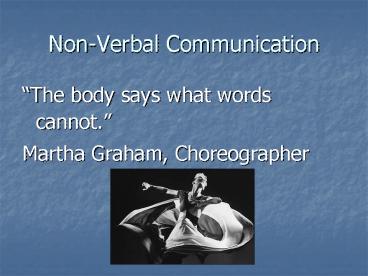NonVerbal Communication - PowerPoint PPT Presentation
1 / 30
Title:
NonVerbal Communication
Description:
Non-Verbal Communication 'The body says what words cannot.' Martha Graham, Choreographer ... Expectancy Violations Theory. Protection Theory ... – PowerPoint PPT presentation
Number of Views:501
Avg rating:3.0/5.0
Title: NonVerbal Communication
1
Non-Verbal Communication
- The body says what words cannot.
- Martha Graham, Choreographer
2
Quiz about Non-Verbal Communication
- Thursday, November 10
3
Non-Verbal Communication
4
Body Gestures (Kinesics)
- Emblems
- Illustrators
- Affect Displays
- Regulators
- Adaptors
5
Emblems
- Substitute for words and have rather specific
verbal translations. - Okay sign
- Come Here
- Hitchhikers sign
- Wave
6
Illustrators
- Accompany and literally illustrate verbal
messages. - Fish Tales Hands far apart when talking about
something large
7
Affect Displays
- Movements of the face that convey emotional
meaning. - Happiness, surprise, fear, anger, sadness,
disgust, etc.
8
Regulators
- Monitor, maintain, or control the speaking of
another individual. - Facial expressions and hand gestures
- Keep going
- Slow down
- what else happened?
9
Adaptors
- Satisfy some need
- Three kinds
- Self Adaptors physical need
- Alter Adaptors response to interactions
- Object Adaptors manipulation of an object
10
Facial Feedback
- Facial Feedback Hypothesis facial expressions
influences physiological arousal - Influenced by Culture
11
Facial Management
- Intensify
- Deintensify
- Neutralize
- Mask
12
Eye Communication
- Monitor feedback
- Secure attention and interest
- Regulate or control conversation
- Signal nature of relationship
- Compensate for physical distance
13
Eye Contact
- Average length of gaze in US
- 2.95 seconds
- Mutual Gaze
- 1.18 seconds
- Staring Contest
14
Eye Avoidance Functions
- Civil inattention averting your eyes
- Signal lack of interest
- Block out other stimuli
15
Touch Communication (Haptics)
- Positive Emotions
- Playfulness
- Control higher status person initiates touch
- Ritualistic hello and goodbye
- Task-Related fever, helping out of a car
16
Touch Avoidance
- More likely with people who have communication
apprehension. - High among low self disclosers
- Influenced by age and gender
17
Paralanguage
- Vocal, but nonverbal dimension of speech.
- Rate
- Volume
- Rhythm
- Vocalizations
- Pitch
18
Paralanguage
- Physical impressions
- Personality impressions
- Evaluative impressions
- Status and credibility judgments
19
Persuasion and Paralanguage
- Fast talkers more persuasive, more evaluated
- Fast talkers rated more intelligent and
objective - Too fast in IC creates problems
20
Functions of Silence
- Time to Think
- Hurt Others
- Response to Anxiety
- Communicate Emotional Responses
- Achieve Specific Effects
- Nothing to Say
21
Spatial MessagesProxemic Distances
- Intimate Distance
- Personal Distance
- Social Distance
- Public Distance
22
Spatial MessagesTheories About Space
- Protection Theory
- Equilibrium Theory
- Expectancy Violations Theory
23
Protection Theory
- Establish a buffer zone around your body as
protection against unwanted touching or attack
24
Equilibrium Theory
- The greater the intimacy the closer the distance.
25
Expectancy Violations Theory
- Explains what happens when you increase or
decrease distances in IC - Cultural expectations
- Idiosyncrasies
- Small violations
- Heighten preconceived notions
26
Spatial MessagesTerritoriality
- Possessive reaction to an area or particular
object - Primary your room, desk
- Secondary neighborhood, favorite table
- Public shopping mall, city park
27
Markers
- Central items reserving a place
- Boundary fence, armrests between chairs
- Ear marking an object to show its yours
28
Artifactual Communication
- Space Decoration
- Color Communication
- Clothing and Body Adornment
29
Olfactory Communication
- Smell communication
- Attraction messages
- Humans emit sexual attractions
- Odors to feel better
- Taste impaired without smell
- Memory messages
- Identification Messages
30
Non-Verbal Communication































